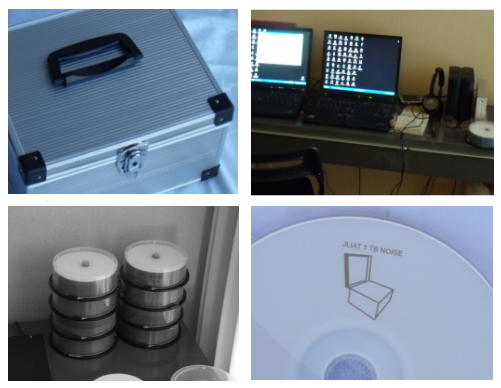
Schemeatic of Process


Schemeatic of Process

1tb
Technical background:
The piece was made using DVDs, each of which can hold a MP3 file of about 4 gigabytes.
MP3 format was chosen not only for its length and ubiquity but as a result of
experimenting with wave files (PCM data on CD) which have an upper limit of 4GB.
Furthermore the MP3 format has structural advantages for creating large files
from segments. Each of the 233 DVDs contains a single MP3 file made by custom
software which creates a file using a “database” of mp3 samples – selecting and
making random segments to create each file for subsequent burning to DVD. The
source of the “Database” is from processed harsh noise sample modules using
effects as shown in the schematic.
Work originally began several years ago using wave files, it was here that the 4GB
limit was discovered. Another setback to the project was the time taken
to create large files. The programming language and methods used meant that
creating even files around 4GB was slow, not only this but the process of running
these programs over many days caused hard disk failures. The current program was
re-written to use file streaming provided by the dot Net framework, this reduced
the processing time to one which made the project viable. The Database was built
through late 2011 and tests were made in December 2011 to see if the project was
viable, actual production took place January 2012 through February 2012.
(A previous attempt at this project in 2009 / 10 had been abandoned).
Future:
Amongst other ideas / provisional ‘objects’ are ones using extended ‘Shuffle’ playing
of mp3 tracks similar to those found on personal mp3 players, but using custom
software developed from the code used for this project, Using a library of many
thousands of tracks it is possible to create pieces of ‘large size and length’
-Massive Harsh Noise Works (MHNW).
Exegesis (part!):
Limits seem to be profound, as well as trivial. Profound both philosophically and
physically, limits to knowledge and limits to its reliability …. Limits of time and
space…limits to understanding, and knowledge of things in themselves, limits to communication.
The more pedantic limits, of society and the law, and the limits of praxis.
The speculative theo/philosophical metaphysics of limits (ontologies) and the
ontic limits of actuality and human finitude.
Some of the metaphysical limits of speculative philosophy, physics/cosmology and mathematics,
have no determinative finite limits at all. Within the ‘practice’ of art, including sound /
music there are always actual physical limits which the artist as practitioner has to deal with.
An exception might be (true) conceptual art, which ‘perhaps’ is free to speculate like those others,
however how their speculations will not fall into those other camps is difficult to see.
Conceptualizing practice, and practical processes however can produce finite works,
objects, which are in part logical and practical consequences of idealities ,
the work of Sol LeWitt for instance.
Massive Harsh Noise Works are not to be confused with other “long” duration sound works,
such as Cage and Eno’s which are instructional and rely on future machines /
cultures to fulfil their speculations. In these the ‘practice’ is
not engaged either by the artist or audience due to their size.
They are more ontological than ontic, more metaphysical than physical….
With Massive Harsh Noise Works this is not the case, the artist is involved in
the finitude of creation, there is no speculation either metaphysical or mystical,
any gnosis lies in the “Real”. And the nature of this reality and its non-gnosis
(as really Real) is in the contingency of “noise” as opposed to the “meaning” of music.
For any prospective audience it is an object and also a potential,
and a problematic, however one which the individual human being can resolve.
The works essence is not resolved ‘as hearing’, but that itself could be
regarded as a possible performance on the part of the ‘listener’ which is
an addition to the status of the work – as it is.
Here the works are truly ‘experimental’ in the sense of the
French translation of ‘experiment’, which can be translated back
into English as either ‘experiment’ or ‘experience’. They are therefore
experiential, both from the creative and potentially
the receptive points of view.
A terabyte (a trillion bytes) has other interesting foci.
The trillion has recently made a wider appearance in society,
mathematically it might be of insignificance, but as a number
its become one we now have to deal in the mundane world,
significantly even if a human being could not live long enough
to count up to a trillion. It is a finitude, but for human
purposes can be regarded as an infinite task. With a terabyte
sound work its creation and reception is finitely possible,
which here it ‘is’, and so its being can be ‘known’ as an
experience, and it can be heard, though if anyone does do this
they will have (also?) made a remarkable achievement.
Given this its almost axiomatic that JLIAT would create such a piece.

A short sample of preparatory work- from proof of concept MP3s
appears on The Wire tapper 28 Issue 338 April 2012 –
Study for forthcoming 1 Terabyte DVD Noise release - 233 x DVD box set
(Schönberg Sechs kleine Klavierstücke, Op. 19)